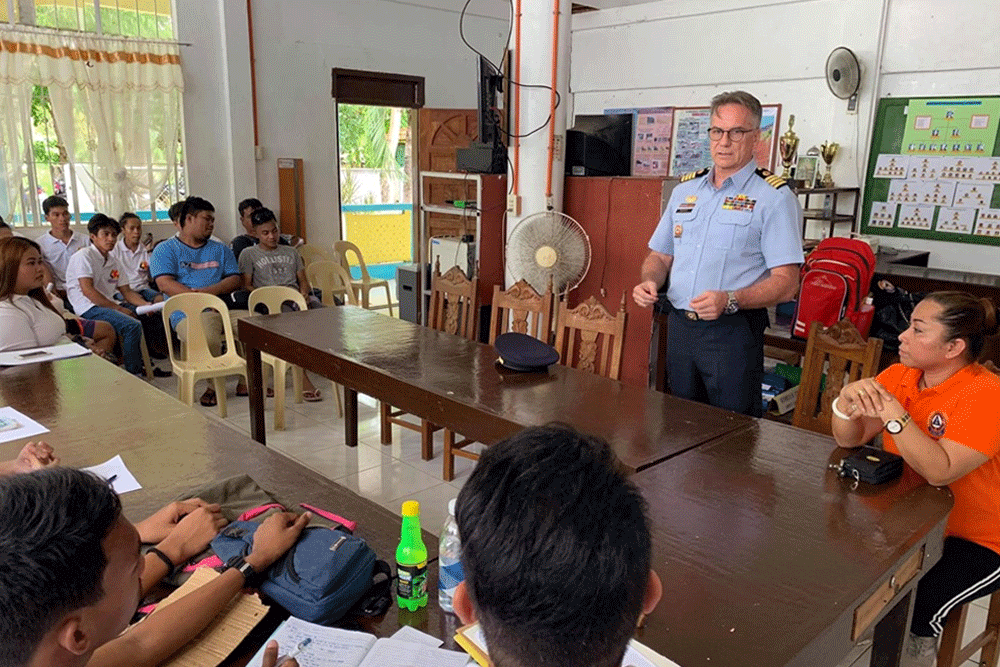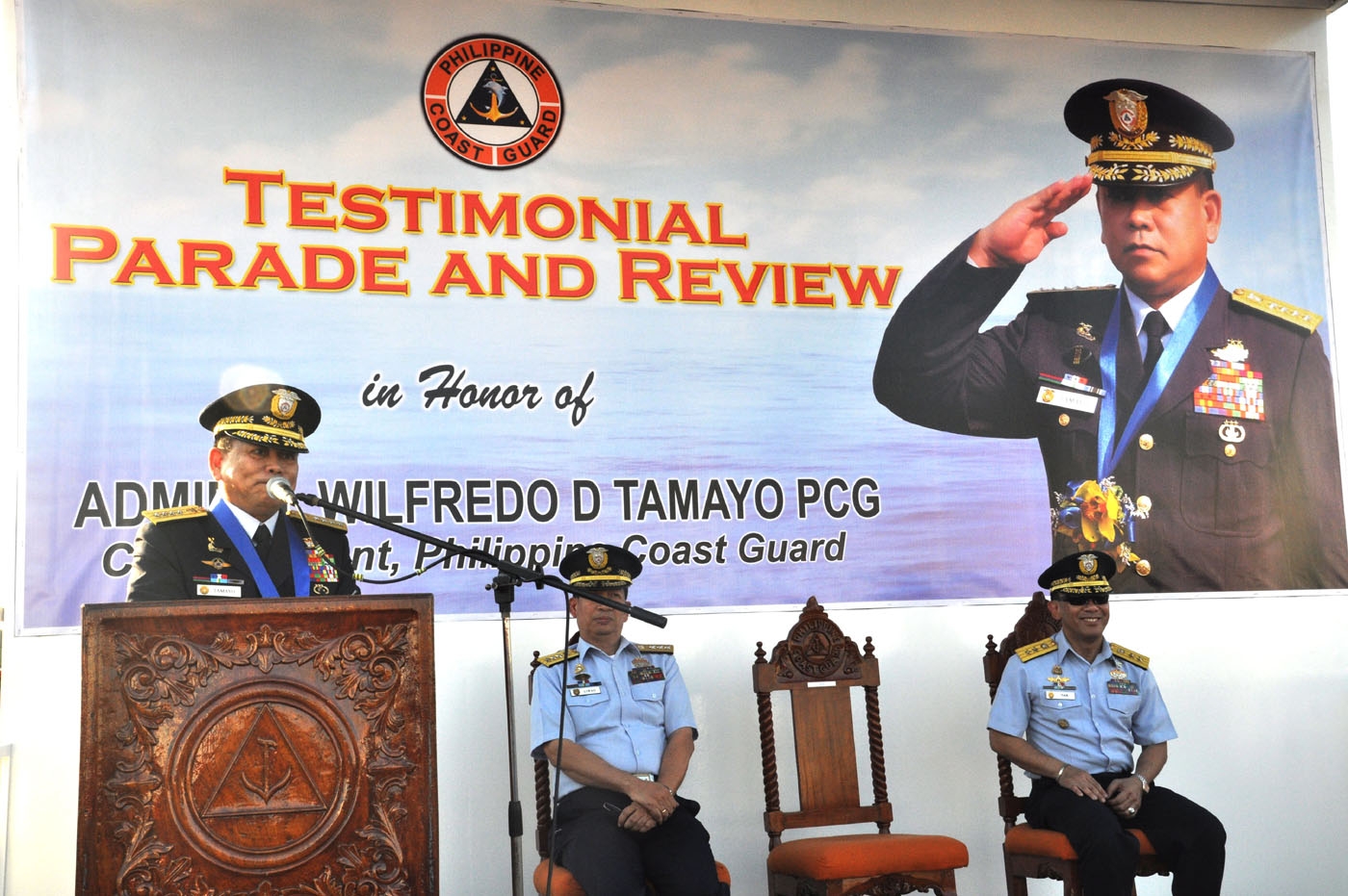Latest Wilfredo Tamayo News and Updates
- Details
- Written by staff
Today the CGADCV together with the 203rd Squadron Director of Bohol CDR IVY BULAYBULAY KUNG PCGA conducted a pre-orientation at the barangay hall of Mag Tong Tong on Pangangan island (Cdr Ivy was informed and asked for this event only yesterday). The meeting was coordinated by Sepe Tutor Mark Paul and Cdr Kung.
Present were 30 Sanggunian Kabataan - SK leaders from various Barangay’s of Calape presented by the federation chairman JT Wong.
We thank Mr. Wong for the opportunity to give everybody a brief overview of what the PCGA is all about, the law behind the organization, the relationship in between PCG and PCGA, our mandated functions, a few comments on the duties and responsibilities, volunteerism, a brief on uniforms and other dress codes, divisions, squadrons and districts, what is expected from the members after the official orientation, indoctrination and induction and monetary involvements.
The membership requirements were explained also by Cdr Kung.
Looking forward to work with the future Calape division via the 203rd Squadron Bohol.
CAPT HOLGER HORN PCGA
#coastguard #pcga #pcg
- Details
- Written by staff
To promote safety of life and property at sea, safeguard the marine environment and resources, enforce all applicable laws within the Philippine waters, assist in maritime security operations, conduct search and rescue, and perform other activities in support of national development.
- Details
- Written by staff
The Philippine Coast Guard (PCG) dragon boat team started as an all-male crew in March, 2007, during the incumbency of Commandant Admiral Damian L. Carlos (Ret.) It was, however, a brief existence, and the team went on hiatus until 2010, under the leadership of Vice-Admiral Wilfredo D. Tamayo (Ret.) By this time, there were both men and women paddlers. The PCG dragon boat team was formed with the mission to represent the command in both international and local races, to uplift the image of the PCG as a sea-going service and an active participant in water sports.
Initially, the teams were composed of seven PDBF national athletes and organic members of the PCG who qualified during the tryouts. These national athletes became draftees in March 2007 and became members of Coast Guardman’s Course (CGMC) Class 17-2008. In October 2010, six more national athletes applied for enlistment into the PCG. Satisfying all the requirements for applicants, they became members of CGMC Class 19-2010, making a total of 13 organic PCG personnel in the pool of national athletes in the PSC/POC. These PCG national athletes, together with organic PCG personnel, represented the command in various local/PDBF-sanctioned races. Together with the athletes from the other branches of service like the AFP and the PNP, the PCG represented the country in various international competitions such as the SEA Games, Asian Games and other IDBF-sanctioned competitions.
The PCG is the main government agency with the mandate to protect and care for our seas and other bodies of water. As such, the team does not only provide a well-rounder sports training program overseen by national athletes, but it also offers many opportunities for outreach activities and social responsibility. Joining the PCG dragon boat team opens up opportunities for paddlers to become proactive in their concern for the sea through coastal clean ups, water rescue and lifesaving trainings, and other awareness-raising activities for the maintenance and rehabilitation of our marine and coastal seas. Paddlers for the PCG are active participants in relief efforts during natural calamities.
Training days are Wednesday, Friday and Saturday, starting at 0600H, at the PCG Headquarters Slipway facility. Civilians are welcome to join the team. Contact 527 84 81 loc. 6295 or e-mail This email address is being protected from spambots. You need JavaScript enabled to view it. for inquiries.
for more information https://dragonboat.ph/teams-archive/philippine-coast-guard-dragon-boat-team/
- Details
- Written by staff
The Memorandum of Agreement aims to strengthen cooperation among both uniformed and armed agencies in disaster response information sharing and cross-training exercises for their respective rescue personnel.
Leading in signing the MOA for their respective agencies last February were Admiral Wilfredo D. Tamayo and Director General Raul Bacalzo. The signing was attended and witnessed by other Coast Guard and National Police officers.
This signing of the MOA is in response over the pronouncement of Philippine Atmospheric, Geophysical & Astronomical Services Administration (PAGASA) that more than 20 tropical storms were expected to visit the country this year. The number of storms can possibly carry heavy and continuous rains as well as landslides around the country. Through the MoA the enhanced SAR can provide a big help for the public.
Wilfredo Tamayo expressed his thanks to Bacalzo for the initiative, stressing the public will undoubtedly benefit from the cooperation as this will improve the ‘capacity-building measures’ of both agencies to effectively respond to emergencies brought about by different natural calamities.
The inevitable results due to “climate change” which is expected to result in rising sea level and storm surges have made it imperative for government agencies to “work together, develop their interoperability and strengthen their partnership”, said the Coast Guard Chief.
The PCG has been involved in various “water search and rescue cross-training” programs with other agencies. Last year, the Philippine Army units, PNP Maritime Group and the Armed Forces of the Philippines (AFP) personnel underwent rubber boat operations training along Manila Bay near the PCG headquarters as part of water rescue and emergency evacuation procedures.
In addition, more than 500 civilian volunteers were taught disaster-response from various barangays and subdivisions Cainta, Rizal, Quezon City, Marikina City, Parañaque City and other metropolitan areas and nearby provinces, which were severely flooded by typhoon “Ondoy”.
A little more than a week back, the Philippine Red Cross (PRC) led by its chairman former Sen.Richard “Dick” J. Gordon also brought newly-acquired amphibian vehicles to the PCG headquarters for joint training of PRC, PCG and the Philippine Marine Corps.
- Details
- Written by staff
The Philippine Coast Guard (PCG) published last week the revised rules on grounding of vessels during extreme weather conditions, with the shipping industry saying it would better facilitate trade and commerce. The revised rules, titled "Guidelines on Movement of Vessels During Heavy Weather," were in memorandum circular 01-09 issued on Feb. 5. It prohibits vessels less than 1,000 gross tons from sailing under public storm signal 1 within the point of origin, path and destination.
The rules would take effect 15 days after publication, or on Feb. 20, said Vice-Admiral Wilfredo D. Tamayo, PCG commandant. Mr. Tamayo Sunday said affected stakeholders such as Philippine Interisland Shipping Association (PISA), Philippine Liner Shipping Association, Filipino Shipowners’ Association, Alliance of Philippine Fishing Federations, Inc., Lighterage Association of the Philippines and the Masters and Mates Association of the Philippines and industry regulators Maritime Industry Authority and Philippine Ports Authority took part in crafting the new policy.
Mr. Tamayo said in an interview that all vessels are grounded if signal 2 is raised within the point of origin, path and destination. Vessels that have sailed under this weather condition would be advised to take shelter. The circular has lifted the interim rules that automatically prohibited all vessels from sailing under signal 1. "It’s a welcome development. It will help liners meet their scheduled trips. Passengers and cargo owners should also be able to plan their trips and meet their commitments with better accuracy," Josefina C. Maitim, PISA officer-in-charge, said in a text message. The new directive resulted from the review of an earlier policy issued by PCG on June 2007 that banned all vessels from sailing only when storm signal 3 and 4 are raised. Vessels with less than 1,000 gross tons are banned from sailing during signal 1, while vessels with less than 2,000 gross tons are not allowed to sail during signal 2. The earlier directive was reviewed following the sinking of Sulpicio Lines, Inc.-owned M/V Princess of the Stars last June 21 off Sibuyan island in Romblon province. The 23,800-ton liner sailed on June 20 as signal 1 was raised in Metro Manila and signals 2 and 3 were raised on its path. The vessel, which was en route to Cebu from Manila, carried over 850 passengers and crew, but only a little over 30 survived. - BusinessWorld




